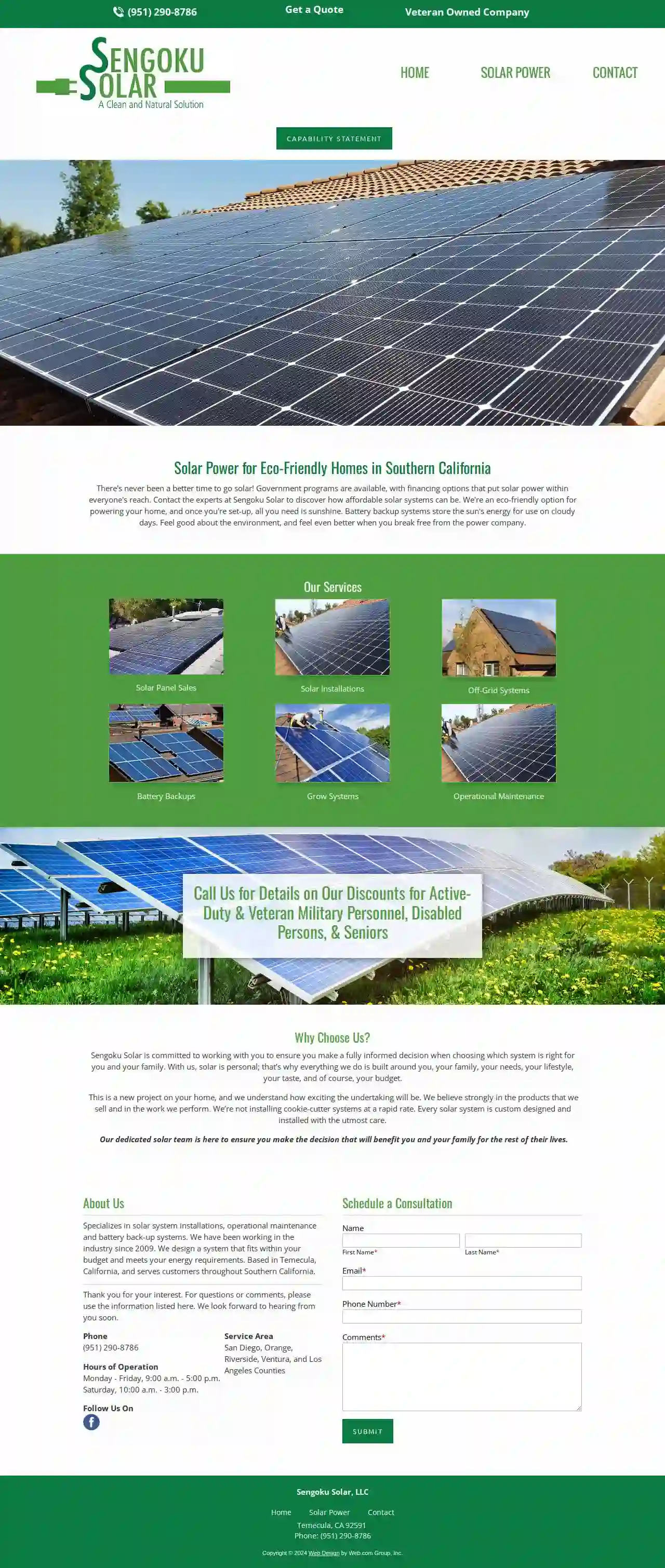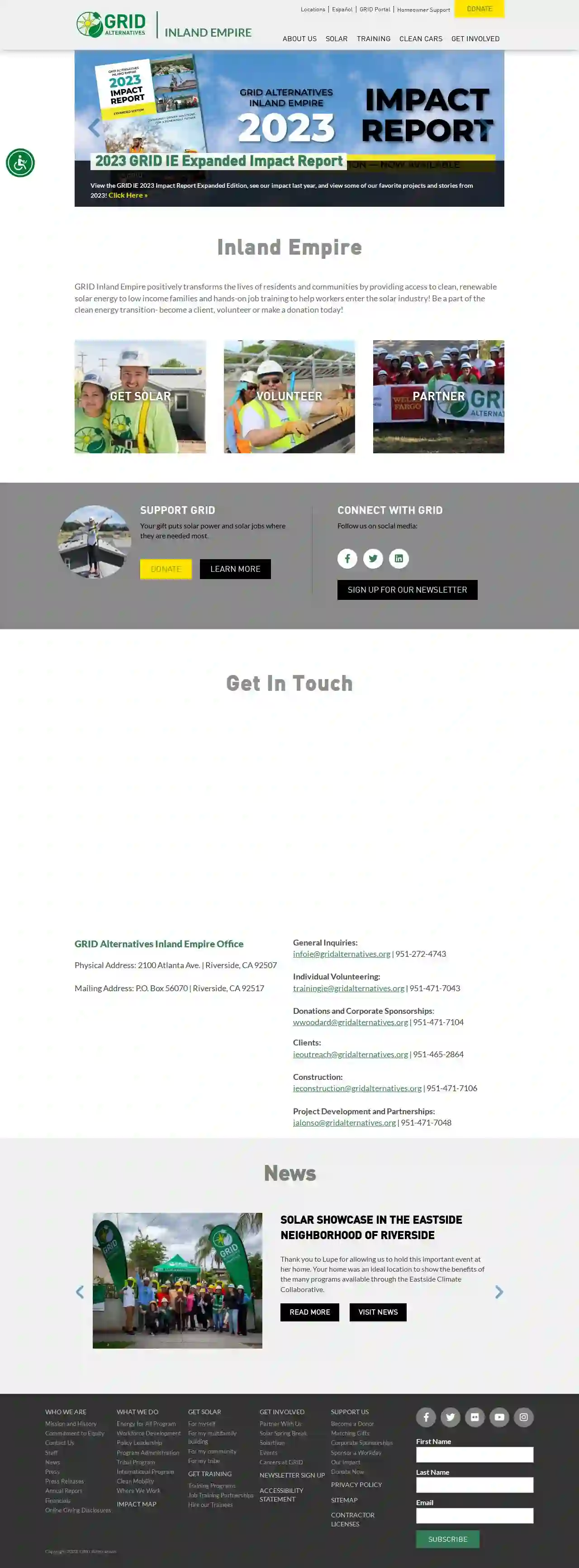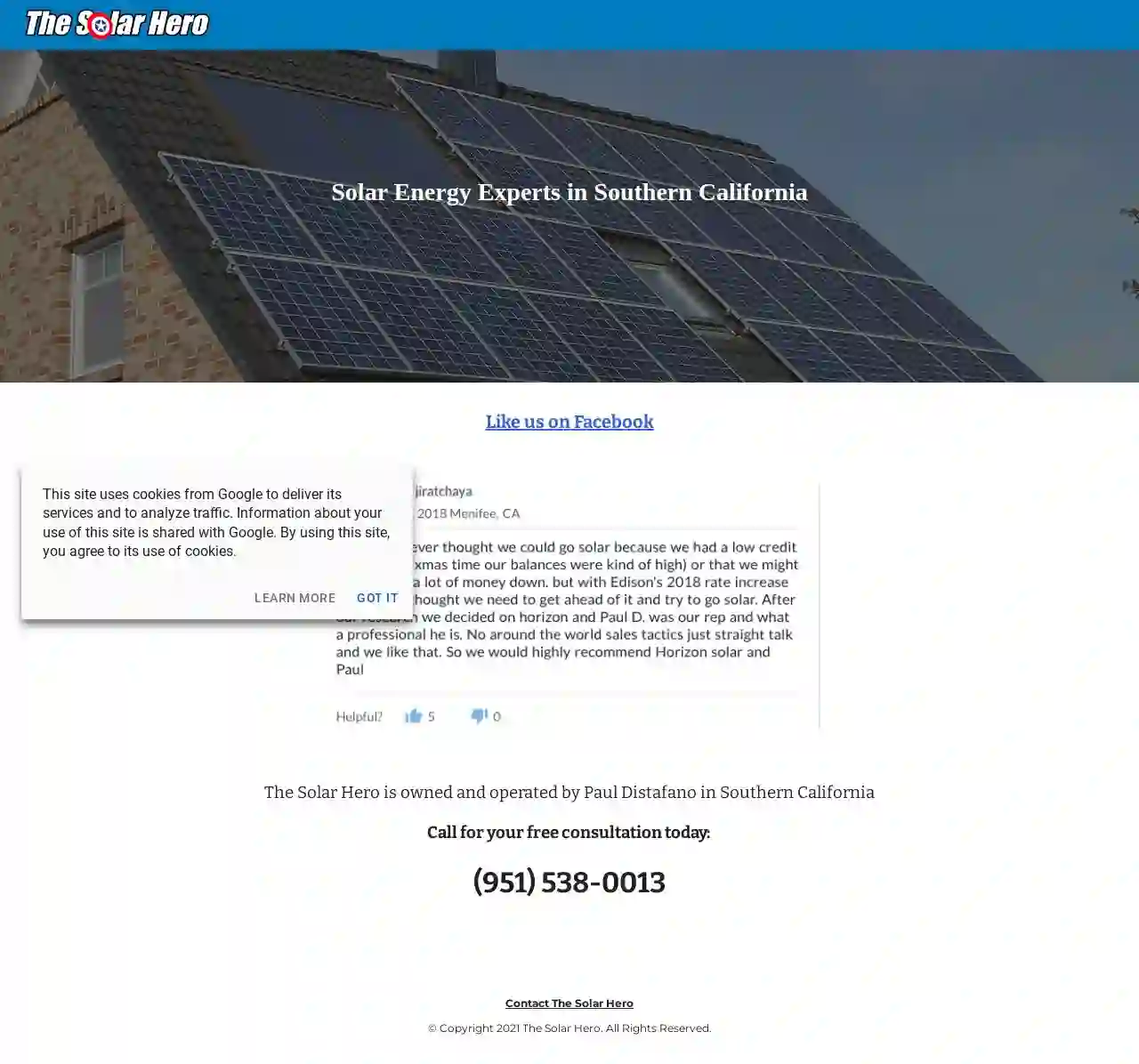Solar Installers Quartz Hill
Find top Residential Solar Installers in Quartz Hill
Get up to 3 Residential Solar Installers quotes for your project today! Compare profiles, reviews, accreditations, portfolio, etc... and choose the best service.

SunPower by Sun Solar
52 reviewsActon, CA, 123 Solar Way, 93510, USSunPower by Sun Solar is a leading provider of solar solutions, offering a range of services including residential and commercial solar installations, solar maintenance, and battery storage solutions. With a focus on energy efficiency and sustainability, SunPower by Sun Solar aims to help customers reduce their energy bills and carbon footprint. The company serves various areas including Antelope Valley, Central Coast, Fresno, and more.
- Services
- Why Us?
- Accreditations
- Our Team
- Testimonials
- Gallery
Get Quote
Sengoku Solar, LLC
Temecula, CA, 123 Solar Way, 92591, USSengoku Solar specializes in solar system installations, operational maintenance, and battery back-up systems. We have been working in the industry since 2009. We design a system that fits within your budget and meets your energy requirements. Based in Temecula, California, and serves customers throughout Southern California.
- Services
- Why Us?
- Accreditations
- Our Team
- Testimonials
- Gallery
Get Quote
CalState Solar and Roofing
3.97 reviewsMurrieta, CA, 29990 Technology Drive #14, 92563, USServing California’s Solar Needs Solar For New Home Builders Learn More Innovative Solar For Every Situation Residential Solar Owning solar has never been a more attractive option. By matching the right technology with the best financing packages on the market, CalState Solar has been able to bring the best fixed rate residential solar systems to California for over a decade. Learn More Homebuilder Solar Our industry-leading solar systems, attention to detail, timely installation, and customized plans for builders will set you apart and appeal to buyers seeking sustainable and environmentally friendly energy in the competitive California real estate market. Learn More Commercial Solar Commercial solar panel installation and design objectives vary widely, from offsetting your everyday energy demands to a commercial solar farm covering several acres of land. Our team has the experience to maximize your situation and budget. Learn More Flip The Switch On Solar For Your Home In 3 Easy Steps Free Consultation Your solar specialist will guide you through everything you need to know about installing solar panels in California including available tax credits and incentives, financing and return on your investment. System Design We professionally design your solar electric system to ensure you get the most convenient, reliable and economical solar PV system available based on your home or business needs to maximize your savings. Installation & Activation Our solar technicians are experts at installing reliable, attractive solar panel systems in California using only the best solar technology available to maximize your power savings and get your home powered up fast. Get Started Today Hear What Our Customers Have To Say! “CalState Solar has proven to be the “go to company” when it comes to solar. They are a proven trade partner that goes above and beyond for their clients to ensure that all aspects, from the system array design to getting the approval for the system to be turned on, are professionally handled. I would recommend Cal State Solar to any homeowner and/or homebuilder looking to have a solar system installed.” Jared Hendricks Vice President of Purchasing | City Ventures “I highly recommend using CalState Solar on your next project because of their hands on attention to detail at pre planning stages all the way to install, including providing very competitive pricing.” Kayvon SaremaslaniPurchasing Director | Watt Communities “Working with CalState Solar is a pleasure. They are a true partner and always go above and beyond to ensure that our projects are completed on time and within budget. Their expertise in solar and roofing is unmatched and their customer service is top-notch.” Michael S. CEO | SunStreet Homes “CalState Solar has been a valuable partner for our company. Their professionalism, expertise, and attention to detail have been instrumental in helping us achieve our sustainability goals. We highly recommend them to anyone looking for a reliable and efficient solar installation company.” John D. President | Green Earth Builders “CalState Solar is a company that truly cares about their customers. They take the time to understand your needs and provide a customized solution that fits your budget and lifestyle. Their team is knowledgeable, friendly, and always willing to go the extra mile to ensure your satisfaction.” Sarah K. Homeowner
- Services
- Why Us?
- Testimonials
- Gallery
Get Quote
PTS Solar
123 Solar Way, Suite 100, Solar City, 12345, USPTS Solar is a leading provider of solar panel solutions, offering design, consulting, and implementation services. With a focus on customer satisfaction and green energy, PTS Solar aims to provide the best solutions for power needs. Their services include solar panel installation, maintenance, and repair. PTS Solar emphasizes the benefits of using solar panels, including lower electricity costs and a greener environment. They also provide information on how solar panels work, even in cold weather, and the basics of solar photovoltaic cells.
- Services
- Why Us?
- Accreditations
- Our Team
- Testimonials
- Gallery
Get Quote
GRID Alternatives Inland Empire
4.526 reviews2100 Atlanta Ave., Riverside, CA 92507, 92507, USGRID Alternatives Inland Empire positively transforms the lives of residents and communities by providing access to clean, renewable solar energy to low income families and hands-on job training to help workers enter the solar industry! Be a part of the clean energy transition- become a client, volunteer or make a donation today!
- Services
- Why Us?
- Accreditations
- Our Team
- Testimonials
- Gallery
Get Quote
THE SOLAR HERO
4.927 reviewsMurrieta, US- Services
- Why Us?
- Gallery
Get Quote
Solar Vast
12 reviewsBeverly Hills, CA, 123 Solar Way, 90210, USSolar Vast is a company dedicated to making saving the environment simple. They strive to perfect their solar and roofing systems in durability and design, aiming to exceed customer expectations. Their mission is to make it easier for individuals to feel the difference and save the planet one solar panel at a time.
- Services
- Why Us?
- Accreditations
- Our Team
- Testimonials
- Gallery
Get Quote
Silicon Solar
Bainbridge, NY, Solar Energy Showroom & Training Center, 2907 State HW 7, 13733, USSilicon Solar is a family-owned and operated business since 1999, offering a wide range of solar products and services including solar fountains, solar sign lights, solar panels, solar battery chargers, solar hot water, and solar landscape lights. They also provide design and manufacturing services for custom solar solutions. Their mission is to provide sustainable and innovative solar energy solutions to their customers.
- Services
- Why Us?
- Accreditations
- Our Team
- Testimonials
- Gallery
Get Quote
V3 Electric
4.3159 reviewsV3 Electric Headquarters, Suite 100, 123 Solar Way, Los Angeles, 90001, USV3 Electric is a premier solar provider in California, offering a range of solar options and Tesla Powerwall solutions. The company is driven by a cause to provide freedom of choice in energy, disrupting the traditional utility companies. With thousands of happy customers and over 1 million dollars in customer savings, V3 Electric is committed to giving people more freedom in their energy choices.
- Services
- Why Us?
- Accreditations
- Our Team
- Testimonials
- Gallery
Get Quote
Los Angeles Solar Panel
525 reviewsLos Angeles, CA, 123 Solar Way, 90001, USLos Angeles Solar Panel is dedicated to revolutionizing the way energy is sourced, consumed, and conserved in the vibrant city of Los Angeles. With a passion for sustainability and a commitment to excellence, we’ve been serving the Los Angeles community for years, delivering cutting-edge solar panel installations and services to homeowners, businesses, and organizations alike. Our mission is simple: to empower individuals and businesses to embrace clean, renewable energy while reducing their carbon footprint and energy costs.
- Services
- Why Us?
- Accreditations
- Our Team
- Testimonials
- Gallery
Get Quote
Over 4,210+ Solar Businesses on our platform
Our solar pros operate in Quartz Hill & surrounding areas!
SolarCompaniesHub has curated and vetted Top Solar Contractors in and around Quartz Hill. Find a top & reliable contractor today.
Frequently Asked Questions About Solar Installers
- System size (measured in kilowatts, or kW)
- Type of solar panels (monocrystalline, polycrystalline, thin-film)
- Roof complexity (pitch, size, obstructions)
- Labor costs in your area
- Available incentives and rebates
- Cash Purchase: The most straightforward option, providing the greatest long-term savings but requiring a larger upfront investment.
- Solar Loans: Loans specifically designed for solar installations, often with favorable terms and interest rates.
- Solar Leases: A third-party company owns the system and leases it to you, allowing you to go solar with little or no upfront cost, but you won't own the system or receive tax benefits.
- Power Purchase Agreements (PPAs): Similar to leases, but you pay for the electricity generated by the system, not the system itself.
- Home Equity Loans or Lines of Credit: Borrow against the equity in your home.
- System size
- Roof complexity
- Weather conditions
- Permitting and inspections
- Installer's schedule
What is the average cost of solar panel installation in USA?
How can I finance my solar panel installation?
How long does it take to install solar panels?
What is net metering, and how does it work?
What is the average cost of solar panel installation in USA?
- System size (measured in kilowatts, or kW)
- Type of solar panels (monocrystalline, polycrystalline, thin-film)
- Roof complexity (pitch, size, obstructions)
- Labor costs in your area
- Available incentives and rebates
How can I finance my solar panel installation?
- Cash Purchase: The most straightforward option, providing the greatest long-term savings but requiring a larger upfront investment.
- Solar Loans: Loans specifically designed for solar installations, often with favorable terms and interest rates.
- Solar Leases: A third-party company owns the system and leases it to you, allowing you to go solar with little or no upfront cost, but you won't own the system or receive tax benefits.
- Power Purchase Agreements (PPAs): Similar to leases, but you pay for the electricity generated by the system, not the system itself.
- Home Equity Loans or Lines of Credit: Borrow against the equity in your home.
How long does it take to install solar panels?
- System size
- Roof complexity
- Weather conditions
- Permitting and inspections
- Installer's schedule